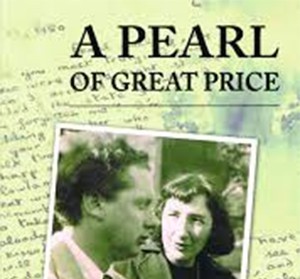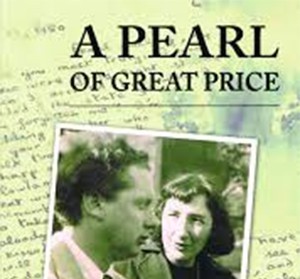Peter Gaskell reviews A Pearl of Great Price, the collection of love letters from Dylan Thomas to Pearl Kazin during their affair in 1950.
Parthian
 The author Elizabeth Hardwick in America and Dylan Thomas wrote that the poet aroused ‘the most sacrificial longings’ in American women. ‘He had lost his looks, he was disorganized to a degree beyond belief, he had a wife and children in genuine need, and yet young ladies felt they had fallen in love with him.’ Pearl Kazin might have been the first of these. She was a literary editor at Harper’s Bazaar whom he met in 1950 when he approached the magazine to have ‘A Child’s Christmas In Wales’ published in New York. Their affair is chronicled in John Malcolm Brinnin’s Dylan Thomas in America which scandalised the literary world when it was published in 1955 (to the extent Thomas’s friend and fellow poet Vernon Watkins moved to refuse permission for publication of his correspondence with Dylan Thomas). Yet far from taking easy advantage of any apparent sacrificial longings, Brinnin makes the point that Kazin’s professional sophistication, her dark handsomeness and social poise ‘made her precisely the sort of woman from whom one would expect Dylan Thomas only to flee’.
The author Elizabeth Hardwick in America and Dylan Thomas wrote that the poet aroused ‘the most sacrificial longings’ in American women. ‘He had lost his looks, he was disorganized to a degree beyond belief, he had a wife and children in genuine need, and yet young ladies felt they had fallen in love with him.’ Pearl Kazin might have been the first of these. She was a literary editor at Harper’s Bazaar whom he met in 1950 when he approached the magazine to have ‘A Child’s Christmas In Wales’ published in New York. Their affair is chronicled in John Malcolm Brinnin’s Dylan Thomas in America which scandalised the literary world when it was published in 1955 (to the extent Thomas’s friend and fellow poet Vernon Watkins moved to refuse permission for publication of his correspondence with Dylan Thomas). Yet far from taking easy advantage of any apparent sacrificial longings, Brinnin makes the point that Kazin’s professional sophistication, her dark handsomeness and social poise ‘made her precisely the sort of woman from whom one would expect Dylan Thomas only to flee’.
The centrepiece of Love Letters Of Dylan Thomas To Pearl Kazin is the six letters, in facsimile and transcribed, sent to Kazin by Thomas between June 1950 and February 1951. Her side of the correspondence has not survived so we have to surmise from Thomas’s letters what she may have written. The book is well-presented with photographs, being edited and introduced by Jeff Towns who engages the reader’s interest straightaway with a speculative account of their first contact, since the encounter is not on record. He also writes a note on how he came to possess the letters and provides a biography of Kazin in an afterword by her son David Bell. Finally, there is The Jester, a short story of Pearl Kazin’s that shows she can write with engaging vitality too.
Though brief, Dylan Thomas’s letters, as professions of love, contain much that is poetic and the reader should not be disappointed. Initially ‘shy as a badger’ about declaring his love ‘over the fishy sea’, Dylan Thomas is presumably responding to a passionate overture from Kazin when he wonders ‘how I couldn’t have said a hundred times over, such a simple, enormous, (sic) and deeper than the atlantic truth’. Entertaining animal imagery abounds. In the last of his letters, written in Persia, he is foreshadowing the style of Under Milk Wood when he describes ‘young britishers, well-groomed pups with fair moustaches and briar pipes, who in the smoking summer soon age… go bristled about, toss themselves trembly all sleepless night in the toss-trembling bachelors quarters, answer the three-knock knock at the midnight door, see before them in the hot moonlight wet-mouthed Persian girls from the bazaar who ask for a glass of water, invite the girls in, blush, stammer, grope, are lost. These old-young men are shipped back, packed full with shame and penicillin.’
There is much else that is humorous. ‘Last night I opened the door of a car on the wrong side and fell in a pond. Nothing else has happened to me.’ Jeff Towns quotes Brinnin’s references to Dylan Thomas’s tendency to hyperbolic self-deprecation. Here we have it more modestly represented as in his promise that when her train arrives in London,’I will be there to meet it, small, red, fat and in love’, and an apology, ‘Oh what a snivelling note to you, my darling, when I could write two War and Peaces. Believe in me. I’m nasty but I adore you. I wouldn’t hurt you.’
*
But there are passages where Dylan Thomas declares his desperation also. ‘There wasn’t any meaning in the world going round, in the snow-flocks, in the waking and drowning, in the smoke of words.’ Again with animal references, from Letter Three ‘I have been in terrible dejection lately, miserably, sleeplessly, near suicidally, without money. And I find I cannot work. My home is a little belsen, the country, bugger its birds, has ceased to charm.’ By Letter Five, the affair has been disclosed to his wife Caitlin by Margaret Taylor, wife of the historian A.J.P.Taylor, who reportedly is jealous of Pearl and determined to poison the relationship. After a gap of three months, when Pearl had presumably written to express some doubt about their relationship, Dylan Thomas writes that the ‘grey lady’ had called at the Savage Club in London (where Thomas wrote to Kazin) to collect his mail while he was ill with pleurisy. ‘Any letters of yours she destroyed, or hid among her snakes, or framed in her sewer, or sucked up like a hoover into her worms, or celebrated her grey mass before.’ Then at pains to declare his love unequivocally… ‘How can I tell you I love you so you will believe me? If you were near me I could tell you and you would have to believe me or I would put my finger in my navel and unwind myself, I would vanish through my ear and would stretch out one arm from my ear to pull my bottom in, you would have to believe me because the truth would come crackling and screaming out of me and set your hair and breasts alight.’
Although he expresses his joy that he has heard from Kazin again (‘Oh Pearl, Pearl whom I love and want. I was ill in the wards of the worlds but now the snow’s all suns’), we have already been forewarned the relationship is doomed, as in Letter Four he acknowledges ‘there isn’t any future for us’. By Letter Six, more than a profession of love, the writing from Persia is largely an impressionistic piece describing life in Abadan in similar vein to Llaregub, worth reading for its animal imagery alone. This letter though does encourage one to question whether Thomas is writing to serve the relationship he has with his paramour or the reverse.
The last 30 pages of the book is a short story of Pearl Kazin’s about a writer called Kuney who some critics have tried to see as a portrayal of Dylan Thomas. Certainly there are passages that could have been written about Thomas. ‘He could intoxicate himself completely with an alcoholic’s doggedness on words alone,’ and reminding us of Elizabeth Hardwick’s words, being ‘constantly in debt haggling for a few dollars more from this magazine or publisher. His manuscripts were a mosaic formed out of the very disorder in which he lived, words and sentences scrambled together from notes he’s written on a dozen scraps of paper stuffed in pockets.’
By curious synchronicity as Jeff Towns refers, Kazin’s story was published in the same edition of Botteghe Oscure, a multilingual Italian literary magazine, as ‘Llaregub – a piece for radio perhaps’ by Dylan Thomas in 1952. In reading ‘The Jester’, I found myself on the lookout for clues about her relationship with him. While having no sight of the letters she wrote, my inference was that she was the more attentive and bold. In her story she says ‘To go unnoticed – that is the greatest fear – and the risk of exposure is far less to me than the deaths of obscurity’. If we have seen how Dylan Thomas is confessional in the letters, Kazin confides similarly in her story, ‘Something I know escaped the jester’s maw; something marred the image of the dancing clown. As I look straight into the sun without the distorting image of his shadow play, I think I consented to his distortion too easily and the guilt sits like an unbudgeable stone in my breast.’ Kuney being ‘the tireless entertainer, the clown who could always repeat his performance on demand if he could but find another audience’ reminded me of Vernon Watkins writing of Dylan Thomas as a ‘born clown’.
There will be a number of reasons why people come to this book. Some will want to gauge how poetic are Thomas’s professions of love, others merely to indulge a prurient curiosity as to how scandalous might have been his behaviour, or to see whether the book reveals anything that caused his untimely death three years later. Jeff Towns asserts that the letters had a profound effect on Dylan Thomas’s life and the affair was a contributory factor to his untimely death. It is hard to be so sure of this from the letters themselves, though the affair clearly marked a crisis in his life. His confidante Brinnin reports in his scandalising book Dylan Thomas’s confession that ‘I am in love with Sarah (Pearl) and I’m in love with my wife and I don’t know what to do’. Yet Brinnin detects an effort at maturing and refers to a new confidence defined by ‘my first experience of seeing Dylan wrestling with a problem rather than seeking out the means to circumvent it’.
What finally accounted for Dylan Thomas’s untimely death may be what is referred to in a letter quoted at length by Jeff Towns from the poet Elizabeth Bishop to Pearl Kazin shortly after Thomas had died. She discusses the possibility that he had a death wish. There may of course be several contributory factors to his passing and it will be interesting to see how his death is treated in the film A Poet In New York due for release shortly. In anticipation of this, one cannot help but wonder whether Kazin anticipated what might happen to Dylan Thomas as he spent his time in New York after their affair was over. In 1952, Kazin had written so powerfully of the death of Kuney, a writer keen to accept ‘the perversities of New York with a lusty pleasure in its wantonness’. Could ‘The Jester’ have possibly been a speculative tale, spun out of her concern Dylan Thomas may be careering toward death in the same city the next year?
You might also like…
On the anniversary of the iconic poet’s death, Tony De Sarzec examines Dylan Thomas the drinker, and weighs the myths and evidence leading up to his premature death aged 39.
This piece is part of Wales Arts Review’s collection, Dylan Thomas from the Archive.
Peter Gaskell is a regular contributor to Wales Arts Review.











